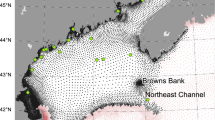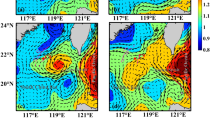Abstract
IN steady-state models of primary production in the open ocean, the upward fluxes of nutrients are balanced by the export of particulate production to the ocean depths. Export production represents the biological effect of carbon production on the net exchange of carbon dioxide between the atmosphere and the ocean. Geochemical estimates of exported production, based on calculations of rates of oxygen usage1 or heat fluxes2 are two to three times as high as those determined from biological measurements3–5. One possible explanation for the differing estimates is that export production, calculated from independent geochemical signals, is too high. Another is that biological measurements severely undersample episodic nutrient injections into the photic zone1,4. Eddy pumping represents one of the possible mechanisms of nutrient injection1. Here we examine the enhancement of production by a cyclonic eddy in the subtropical Pacific with instrumentation that allows us to overcome the sampling problem. Our results reveal that eddy pumping markedly stimulates primary production, and that phytoplankton in the upper oligotrophic ocean outside the eddy are not growing near their maximum relative specific growth rates. But if the relative enhancement of production is typical, our results suggest that eddy pumping would enhance total primary production by only ˜20%.
Similar content being viewed by others
References
Jenkins, W. J. Nature 331, 521–523 (1988).
Hayward, T. L. Deep-Sea Res. 349, 1593–1627 (1987).
Eppley, R. W. & Peterson, B. J. Nature 282, 677–680 (1979).
Platt, T. & Harrison, W. G. Nature 318, 55–58 (1985).
Chavez, F. P. & Barber, R. T. Deep-Sea Res. 34, 1229–1243 (1987).
Patzert, W. C. Tech. Rep. No. 69-8 (Hawaii Institute of Geophysics, University of Hawaii, 1969).
Lobel, P. S. & Robinson, A. R. Deep-Sea Res. 33, 483–500 (1986).
Kolber, Z., Wyman, K. D. & Falkowski, P. G. Limnol. Oceanogr. 35, 72–79 (1990).
Bienfang, P. K. & Szyper, J. P. Deep-Sea Res. 28, 981–1000 (1981).
Kolber, Z., Zehr, J. & Falkowski, P. Plant Physiol. 88, 923–929 (1988).
Laws, E. A., DiTullio, G. R. & Redlje, D. G. Limnol. Oceanogr. 32, 905–918 (1987).
Falkowski, P. G., Wyman, K. D., Ley, A. C. & Mauzerall, D. C. Biochim. biophys. Acta 849, 183–192 (1986).
Weiss, E. & Berry, J. A. Biochim. biophys. Acta 894, 189–208 (1987).
Genty, B., Briantais, J. M., and Baker, N. R. Biochim. biophys. Acta 932, 102–115 (1989).
Falkowski, P. G. & Kolber, Z. Current Research in Photosynthesis IV (ed. Baltscheffsky, M.) 923–926 (Kluwer, London, 1990).
Betzer, O. R. et al. Deep-Sea Res. 31, 1–72 (1984).
Wyrtki, K., Magaard, L. & Hager, J. J. geophys. Res 81, 2641–2646 (1976).
Author information
Authors and Affiliations
Rights and permissions
About this article
Cite this article
Falkowski, P., Ziemann, D., Kolber, Z. et al. Role of eddy pumping in enhancing primary production in the ocean. Nature 352, 55–58 (1991). https://doi.org/10.1038/352055a0
Received:
Accepted:
Issue Date:
DOI: https://doi.org/10.1038/352055a0
- Springer Nature Limited
This article is cited by
-
Long-term evolution of ocean eddy activity in a warming world
Nature Climate Change (2022)
-
Sexual segregation in the foraging distribution, behaviour, and trophic niche of the endemic Boyd’s shearwater (Puffinus lherminieri boydi)
Marine Biology (2022)
-
Enhancement of Sea Surface Chlorophyll a Concentration by Interaction of Winds and Currents in a Cyclonic Eddy in the Japan/East Sea
Ocean Science Journal (2022)
-
Mass transport of a mesoscale eddy in the South China Sea identified by a simulated passive tracer
Journal of Oceanology and Limnology (2022)
-
Tropical storms trigger phytoplankton blooms in the deserts of north Indian Ocean
npj Climate and Atmospheric Science (2021)





